20.10.2020

Starship SN8 has moved SpaceX through another major milestone with the first ever triple Raptor Static Fire test. Following two preburner tests over the last two nights, SpaceX recycled SN8 and fired up the engines to set the stage for nosecone’s installation – with a header tank – for a repeat test in around a week.
SN8 Static Fire:
Opening with a Sunday night test, which followed an aborted attempt earlier in the week, a number of test windows were set for this week
Although SpaceX has conducted numerous Static Fire tests with its Starship prototypes, this was the first time three Raptors will have been fired together. This includes at SpaceX’s test center in McGregor, Texas – where Raptors are test fired individually.
The test path has been refined over the evolution of Starship, with two objectives within a few hours of each other set to take place.
Once the vehicle has been prop-loaded, controllers can conduct a preburner test – as was the case during the Sunday/Monday overnight window and during the first part of Tuesday testing.
A preburner is essentially a small engine that powers a turbopump. Each Raptor engine has two, one for the liquid oxygen oxidizer and one for the methane fuel.
Providing the data from this objective is deemed acceptable; recycling of the vehicle will prepare for the Static Fire test that will utilize Raptors SN30, 32, and 39.
Although SpaceX does not provide any running commentary or official info into Starship testing, the go to proceed towards the firing of the Raptors is known via Mary (@bocachicagal) hearing a police siren.
Mary, and the other local residents of Boca Chica Village, are provided a heads up of testing, including the notification of a police siren with 10 minutes to the Static Fire.
Not least because this is a unique test for Starship, all three engines’ actual firing still requires a major data check into the system’s health. SpaceX could recycle the test in the days to come.
If the data is good, SN8 will next expect to receive the nosecone that has finally been identified and has since been stacked with its five-ring section.
SpaceX Boca Chica has its own “Noseconeland” at the Production Facility, with numerous nosecones have been seen inside and outside the buildings, including a mated pathfinder nosecone in the Windbreak Facility.
This past week has seen the structural test article removed from the Windbreak, while a few other nosecones were dismantled.
This set the stage for SN8’s nosecone to confirm its destination as it was rolled out of the Big Tent facility and moved into the Windbreak to install its aero surfaces.
On Sunday, the five-ring section – which the nosecone will sit on – was moved into position near the Windbreak as a prelude to a full nosecone mating.
Dependant on SpaceX being happy with the first Static Fire test, the nosecone will be transported to the Launch Site and prepared for mating with SN8.
Once mating operations have been completed, preparations for a second Static Fire test are expected, this time teams will be testing the three Raptors’ firing while pulling Liquid Oxygen from the header tank housed inside the nosecone.
Another data review will then take place, this time to approve the Starship SN8 vehicle for the ambitious 50,000 feet test launch and landing attempt.
SN9 Onwards:
SN8’s test holds a high degree of risk for the vehicle. As such, SpaceX is taking appropriate mitigations to avoid impacts on the overall Starship test path.
That mitigation comes in the form of additional Starships ready to enter the fray within days of being required.
Starship SN9 is now fully stacked inside the Mid Bay and has a new neighbor, with SN10 now undergoing the business end of its stacking operations.
This work is ongoing while additional Starship sections are being staged, with parts up to at least SN14 spotted over recent days.
Simultaneously, an array of sections for a Super Heavy booster are waiting for the clearance to enter the High Bay for the stacking. They will form the first prototype vehicle, which is expected to conduct a 150-meter test hop on two Raptors.
Work on the High Bay is complete from a structural standpoint, with workers now concentrating on preparing the building for the installation of the gantry crane that will undertake the work of stacking the sections on the tall booster.
Quelle: NS
----
Update: 21.10.2020
.
SpaceX Starship fires up three Raptor engines in prelude to high-altitude flight
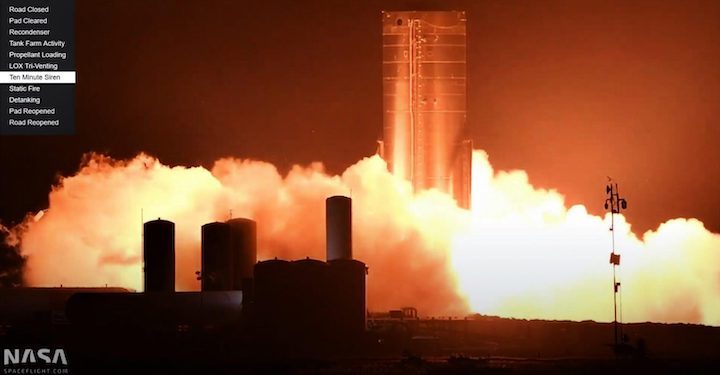
Update: At 1:21am CDT (6:21 UTC) on October 20th, Starship SN8 ignited all three of its Raptors’ preburners, producing a spectacular fireball noticeably larger than the one produced during the rocket’s first October 19th preburner test. A mere two hours later, with no break in between, the steel rocket prototype fully ignited all three Raptor engines for the first time ever, likely producing thrust equivalent to ~90% of a nine engine Falcon 9 booster for a brief moment.
Crucially, aside from physically demonstrating Raptor’s multi-engine capabilities, Starship SN8 – already a first-of-a-kind prototype – completed and survived a static fire seemingly unscathed on its first attempt. If the data SpaceX gathers from the milestone is as good as the test appeared to be, the company could be just a few days away from installing Starship SN8’s recently-stacked nosecone, followed by a second triple-Raptor static fire test. If that second static fire goes well, SN8’s next task will be the first high-altitude Starship flight test.
Minutes after an adjacent highway was scheduled to reopen, SpaceX’s first high-altitude Starship prototype – serial number 8 – attempted what was likely the first multi-engine Raptor test ever.
At 6:01 am, October 19th, Starship SN8’s trio of Raptor engines were barely unleashed, producing a large fireball indicative of a ‘preburner’ ignition test. One of the most complex rocket engines ever developed, Raptor relies on a maximally efficient but temperamental “full-flow staged combustion” cycle (FFSC), a concise name for the many, many steps required to turn liquid propellant into thrust.
Adding additional difficulty, Raptor’s full-flow staged combustion necessitates ignition of gaseous oxygen and methane in the combustion chamber. Given that the Raptor-powered Starship spacecraft and Super Heavy booster exclusively use cryogenic liquid methane and oxygen, a major challenge posed by FFSC is the need to efficiently turn that ultra-cold propellant into hot gas almost instantaneously. This is where gas generators (or preburners) come in.
In a full-flow staged combustion engine, both oxidizer and fuel require their own separate turbopumps, which then require their own preburners to create the pressures needed to power those turbopumps and the gas the combustion chamber ignites to produce thrust. A step further, to enable high combustion chamber pressure like Raptor’s 300+ bar (~4400+ psi), those preburners need to produce gas at far higher pressures to account for energy losses as those gases wind their way through the engine’s plumbing.
As a result, preburners are possibly the single most stressed system in an engine like Raptor. Unsurprisingly, this has often lead SpaceX to separately test each engine’s preburners as a sort of partial static fire before the actual engine ignition test. This is the test Starship SN8 attempted in the early morning on October 19th, representing Raptor’s very first multi-engine ignition event.
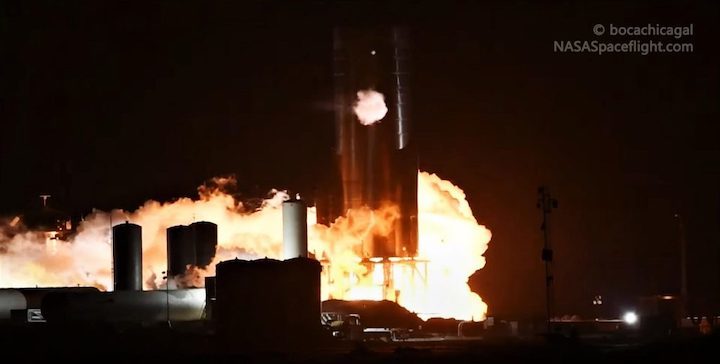
Curiously, moments before preburner ignition, one of the three Raptor engines appeared to command an aggressive jet-like vent of liquid oxygen identical to a vent seen just a few hours prior during the first aborted preburner test. There’s thus a chance that only two of SN8’s three Raptor engines successfully started their preburners
Raptor is the first FFSC engine in the world to fly and – as far as the duration of lifetime testing and volume production goes – is almost certainly the most advanced of the three FFSC programs to graduate to static fire tests. In other words, given that SN8’s test campaign is the first time SpaceX has ever attempted to operate multiple adjacent Raptor engines at the same time, it’s not a huge surprise that progress towards the first three-engine static fire has been cautious and halting. Mirroring its Sunday/Monday testing, SpaceX will put Starship SN8 through another preburner and/or static fire attempt between 9pm and 6am CDT (UTC-5) on October 19/20. Even more 9-6 test windows are scheduled on October 21st and 22nd.

Meanwhile, not long after Starship SN8’s first preburner test was completed, SpaceX teams rolled a section of five steel rings inside a small windbreak and stacked the first truly functional nosecone – already outfitted with forward flaps – atop it. If Starship SN8 survives its first full triple-Raptor preburner and static fire tests, that new nosecone will likely be rolled to the launch pad for in-situ installation, topping off the rocket ahead of a spectacular 15 km (~50,000 ft) flight test.
Quelle: TESLARATI
----
Update: 23.10.2020
.
SpaceX test-fires Starship prototype with three engines
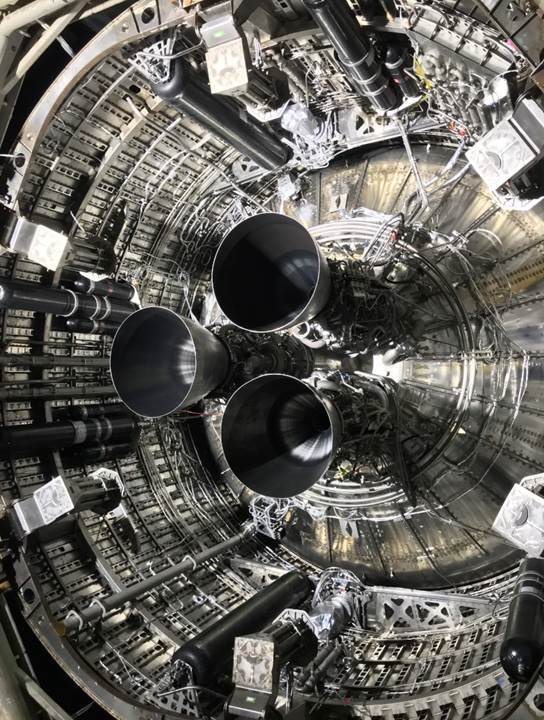
SpaceX fired three Raptor engines on a prototype of the company’s Starship vehicle Tuesday, accomplishing another milestone on the road toward testing of the methane-fueled rocket at higher altitudes.
The three Raptor engines ignited shortly after 4 a.m. EDT (3 a.m. CDT; 0800 GMT) Tuesday on a test stand at SpaceX’s Boca Chica development facility in South Texas. Webcasts of the testing showed the three engines briefly ignited with a flash of orange at the seaside complex.
Elon Musk, SpaceX’s founder and CEO, tweeted later Tuesday the engine firing, called a “static fire,” went according to plan.
“Data from 3 engine Starship static fire this morning looks good,” Musk tweeted. “Proceeding with nosecone mate.”
The test vehicle that fired up Tuesday morning is designated SN8. After additional testing, SpaceX aims to fly the prototype to an altitude of up to 50,000 feet, or 15 kilometers, higher than any Starship has flown before.
SpaceX flew two previous Starship test vehicles to 500 feet, or 150 meters, over the Boca Chica site Aug. 4 and Sept. 3. Those test flights were powered by a single methane-fueled Raptor engine.
The testing of the SN8 vehicle is the next step in SpaceX’s Starship development program, with three Raptor engines mounted at the base of the vehicle. The three throttleable Raptor engines, each capable of producing up to 500,000 pounds of thrust, will allow SpaceX to attempt more ambitious Starship test flights. The addition of fins will also aid in high-altitude, higher-speed flights.
Body flaps have already been installed on the SN8 test vehicle, and SpaceX teams at Boca Chica planned to add the stainless steel nose cone this week after the successful static fire test Tuesday. With the nose cone added, the Starship vehicle will reach a height of around 164 feet, or 50 meters.
The vehicle measures around 30 feet (9 meters) wide, about one-and-a-half times the diameter of a Boeing 747 jumbo jet.
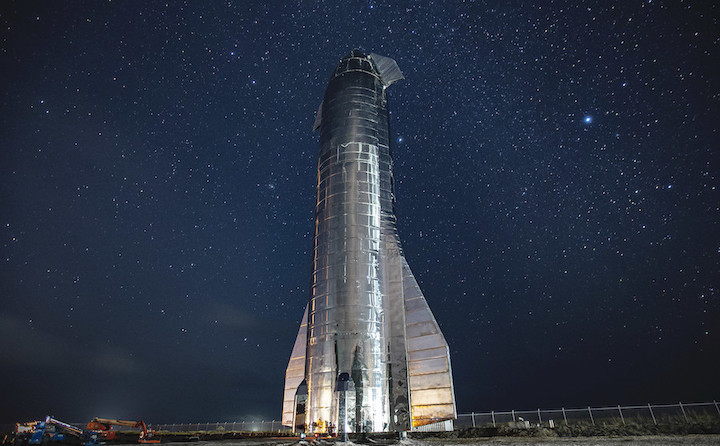
Eventually, SpaceX will mount six Raptor engines at the base of future Starships. Three of the Raptors will be similar to the existing engine models flown to date, while three will be fitted with much larger nozzles.
The engine version with the nozzle extension is known as the Raptor Vacuum, or RVac. SpaceX recently announced on Twitter that the first RVac engine has shipped from the company’s headquarters and Raptor engine factory in Hawthorne, California, to a test site in McGregor, Texas, to begin a series of test-firings.
The RVac engine configuration is needed to power Starship launches into orbit.
The pace of Starship development has hastened in recent months as SpaceX builds out a sprawling production facility at Boca Chica, located just east of Brownsville, Texas, on the Gulf of Mexico near the U.S.-Mexico border.
Once operational, the Starship could carry more than 100 metric tons, or 220,000 pounds, of cargo to low Earth orbit, more than any rocket in the world. With life support systems and in-space refueling, Starship missions could eventually transport people to the moon, Mars, and other distant destinations.
Starship is central to the vision of Musk, who established the company with a mission of sending people to Mars. Future Starships could cruise to Mars with up to 100 people, Musk says.
Musk has emphasized SpaceX’s progress on production capabilities and ground infrastructure, allowing the company to rapidly build prototypes, test them, and introduce upgrades and modifications on follow-on vehicles.
SpaceX has started building parts of the first Super Heavy booster, which will be the first stage on the full-scale Starship vehicle. Starships like the vehicles currently undergoing testing will serve as the upper stage stacked on top of the Super Heavy.
Like the early Starship test flights, the first Super Heavy prototypes will fly to low altitudes with a subset of Raptor engines, beginning with two or four of the SpaceX-made powerplants, Musk said. The final Super Heavy design will have 28 Raptor engines.
For an orbital mission, the Starship will also need a heat shield for re-entry. The entire stack will stand around 394 feet (120 meters) tall, according to SpaceX’s website.
Both stages will come back to Earth for propulsive landings, much like the first stage on SpaceX’s partially reusable Falcon 9 rocket. That will make the Super Heavy and Starship fully reusable.
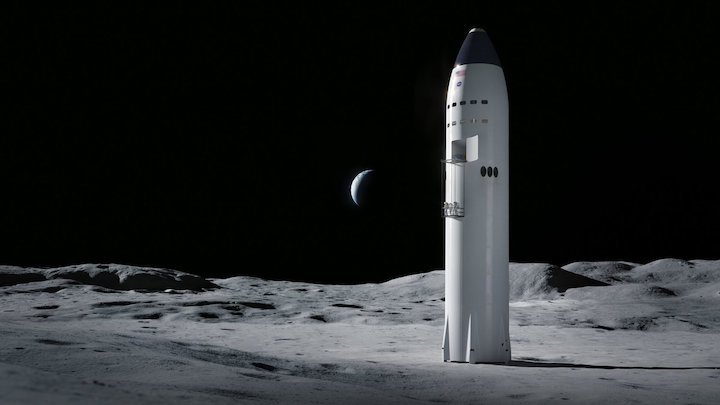
While cautioning that his schedule predictions are “just guesses,” Musk said Oct. 16 that he is “80 to 90% confident that we will reach orbit with Starship next year.
“I’m 50% confident that we’ll be able to bring the ship and booster back,” Musk said in a discussion at the 23rd Annual International Mars Society Convention. “That’s more of a dicey situation. We’ll probably lose a few ships before we really get the atmospheric return and landing right.”
Musk said he believes SpaceX will be “doing high-volume flights probably in 2022, so a couple of years from now.”
“I’m trying to make sure that our rate of innovation increases, (and) it doesn’t decrease,” Musk said. “This is really essential. In fact, if we do not see something close to an exponential improvement in our rate of innovation, we will not reach Mars. A pure linear (rate of innovation) doesn’t get us there. I’ll be dead anyway before it gets there, if its pure linear. If it’s exponential … we could probably send an uncrewed mission (to Mars) in maybe four years.”
Musk said last year said the first orbital launch of Starship could happen in 2020. Despite the project’s fast rate of progress, SpaceX won’t meet that schedule.
Musk said Aug. 31 that SpaceX is not yet performing much development of the life support systems Starships will need to accommodate people. That will come after SpaceX can prove the vehicle can fly successfully.
SpaceX’s longer-term roadmap includes an in-orbit refueling capability to make trips to the moon possible. NASA selected SpaceX’s Starship vehicle in May as one of three contenders — alongside Blue Origin and Dynetics — for a human-rated lunar lander the space agency will fund for crewed moon missions later this decade.
The moon missions will require SpaceX to master in-orbit refueling between two Starships. Musk said he thinks SpaceX has a shot of accomplishing that in 2022.
When could SpaceX have a Starship prototype for a moon mission?
“Probably two or three years,” Musk said. “As soon as you’ve got orbital refilling, you can send significant payload to the moon — significant meaning 100 tons of useful payload at a shot.”
Quelle: SN
----
Update: 6.11.2020
.
SpaceX’s high-altitude Starship launch debut officially has a date
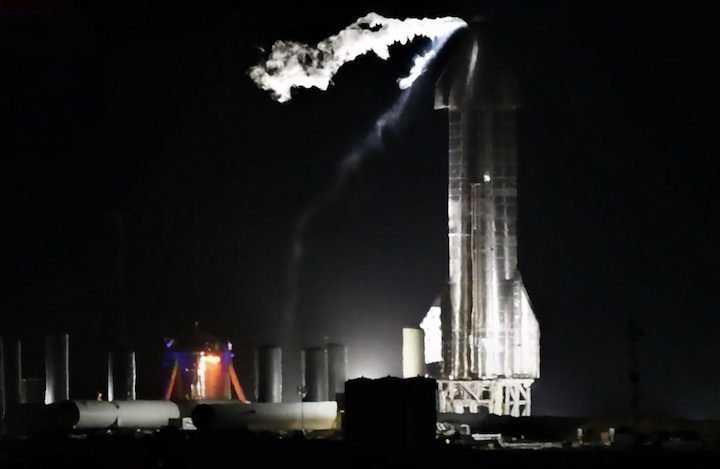
In the form of road closure filings, SpaceX has effectively announced the first possible dates for Starship’s high-altitude launch debut, a high-risk test that CEO Elon Musk recently made clear could fail.
Per road closures published on SpaceX’s dedicated Cameron County, Texas page, Starship serial number 8 (SN8) could apparently be ready for its historic launch debut as soon as November 9th in a 12-hour window that opens at 9am CST (15:00 UTC). Identical 9am-9pm windows on November 10th and 11th will serve as backups in the event of one or several launch aborts or delays – fairly likely for a prototype as complex as Starship SN8.
However, several tests stand between SN8 and flight-readiness, further increasing the odds of delays as SpaceX continues to work out the kinks in what amounts to the first fully-assembly, functional Starship.

Musk has already stated that Starship SN8 will need to complete another Raptor static fire test – potentially with one, two, or three engines – before SpaceX will consider the rocket ready for its flight debut. Over the last few days, NASASpaceflight.com reporter Michael Baylor has noted on livestreams that multiple more static fire tests are actually in order before SpaceX will attempt to launch Starship SN8. It’s currently unclear what the purpose of those additional static fire tests is, given that SN8 has already completed a triple-engine Raptor static fire.
In the two weeks since that milestone, however, SpaceX did take a major step forward, mating Starship SN8’s nose section to create what is effectively the first full-scale, functional prototype. Aside from two smaller forward flaps and attitude control system (ACS) cold gas thrusters, that nose section also contains a small secondary liquid oxygen tank known as a header tank – meant to store a small amount of highly pressurized propellant to be used during Raptor reentry and landing burns. Several months back, Musk revealed that Starship SN4 completed a static fire while only feeding on fuel (liquid methane) stored in the rocket’s methane header tank, making it reasonable to assume that SpaceX wants to repeat a similar test with SN8 while using both fuel and oxidizer header tanks.
For Starship SN8, those header tanks will be an irreplaceable necessity during the rocket’s first attempted launch, free-fall, flip maneuver, and landing. In a clear sign of preparation for a header-tank-only static fire test, SpaceX appeared to successfully complete a cryogenic proof of Starship SN8’s newly-installed nose section and nose (LOx) header tank on November 3rd, verifying that liquid nitrogen – standing in for LOx – can be pumped more than 50 meters (~165 ft) from Starship’s launch mount to the tip of its nose to load said tank.
SpaceX has one more “SN8 nose cone cryo proof” test window scheduled from 8am to 5pm CST Thursday, November 5th that could be used for one or more of those expected static fire tests. Otherwise, SpaceX’s Starship SN18 15 km (~50,000 ft) launch closures were technically filed for an “SN8 Static Fire and 15 KM Flight,” allowing SpaceX to perform one or several static fires before attempting to launch. All things considered, the odds that Starship SN8 will launch on time between November 9th and 11th are probably less than 50:50, but there is definitely a chance.
Quelle: TESLARATI
----
Update: 25.11.2020
.
SpaceX's Starship SN8 prototype fires engines ahead of major test flight
This was static fire number four for SN8. It could launch next week.

SpaceX's latest Starship prototype fired its engines for the fourth time on Tuesday evening (Nov. 24), keeping the vehicle on track for a landmark test flight next week.
The Starship SN8 prototype performed its fourth "static fire" test at 6:23 p.m. EST (2323 GMT) Tuesday at SpaceX's South Texas facility, near the seaside village of Boca Chica.
Static fires, in which engines briefly blaze up while a vehicle remains bolted to the ground, are common preflight checkouts for SpaceX rockets. And SN8 ("Serial No. 8") is indeed gearing up for a flight — a test that will take it to a target altitude of 9 miles (15 kilometers), far higher than any other Starship prototype has gone.
Tuesday's test kept SN8 on target for that milestone leap, SpaceX founder and CEO Elon Musk said.
"Good Starship SN8 static fire! Aiming for first 15km / ~50k ft altitude flight next week. Goals are to test 3-engine ascent, body flaps, transition from main to header tanks & landing flip," Musk tweeted Tuesday evening, about 45 minutes after the test occurred.
Starship is SpaceX's next-generation space transportation system, which the company is developing to take people and payloads to Mars and the moon, launch satellites to orbit and do everything else that SpaceX needs done.
The final version will consist of a 165-foot-tall (50 meters) spacecraft called Starship and a giant rocket called Super Heavy, both of which will be fully reusable. Starship and Super Heavy will be powered by SpaceX's new Raptor engine, which burns liquid methane and liquid oxygen. Starship will sport six Raptors, and Super Heavy will have about 30 of the engines, Musk has said.
The first Super Heavy prototype has not yet been built. But SpaceX has already constructed and tested a number of Starship test vehicles, three of which have already taken flight. A stubby craft called Starhopper flew in the summer of 2019, and SN5 and SN6 got off the ground this past August and September, respectively.
All three of those prototypes were single-engine craft, and they reached a maximum altitude of about 500 feet (150 m). SN8 will go much higher and is therefore quite different than its predecessors, boasting three Raptors as well as a nose cone and stabilizing body flaps.
Starhopper, SN5 and SN6 aced their brief test flights. Musk isn't giving SN8 great odds of doing the same, though he said it won't be a disaster if the vehicle crashes and burns.
"Lot of things need to go right, so maybe 1/3 chance," he tweeted Tuesday evening. "But that’s why we have SN 9 & SN10," he added in another tweet.
SN8's previous three static fires occurred on Oct. 20, Nov. 10 and Nov. 12. The third test didn't go as planned; the Raptors' ignition shattered the top layer of the test pad, sending shards of material into the engine bay and causing a premature shutdown, Musk explained in a tweet last week.
But SN8 bounced back quickly, and it will soon fly high, if all goes according to plan.
Quelle: SC
